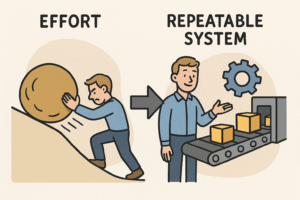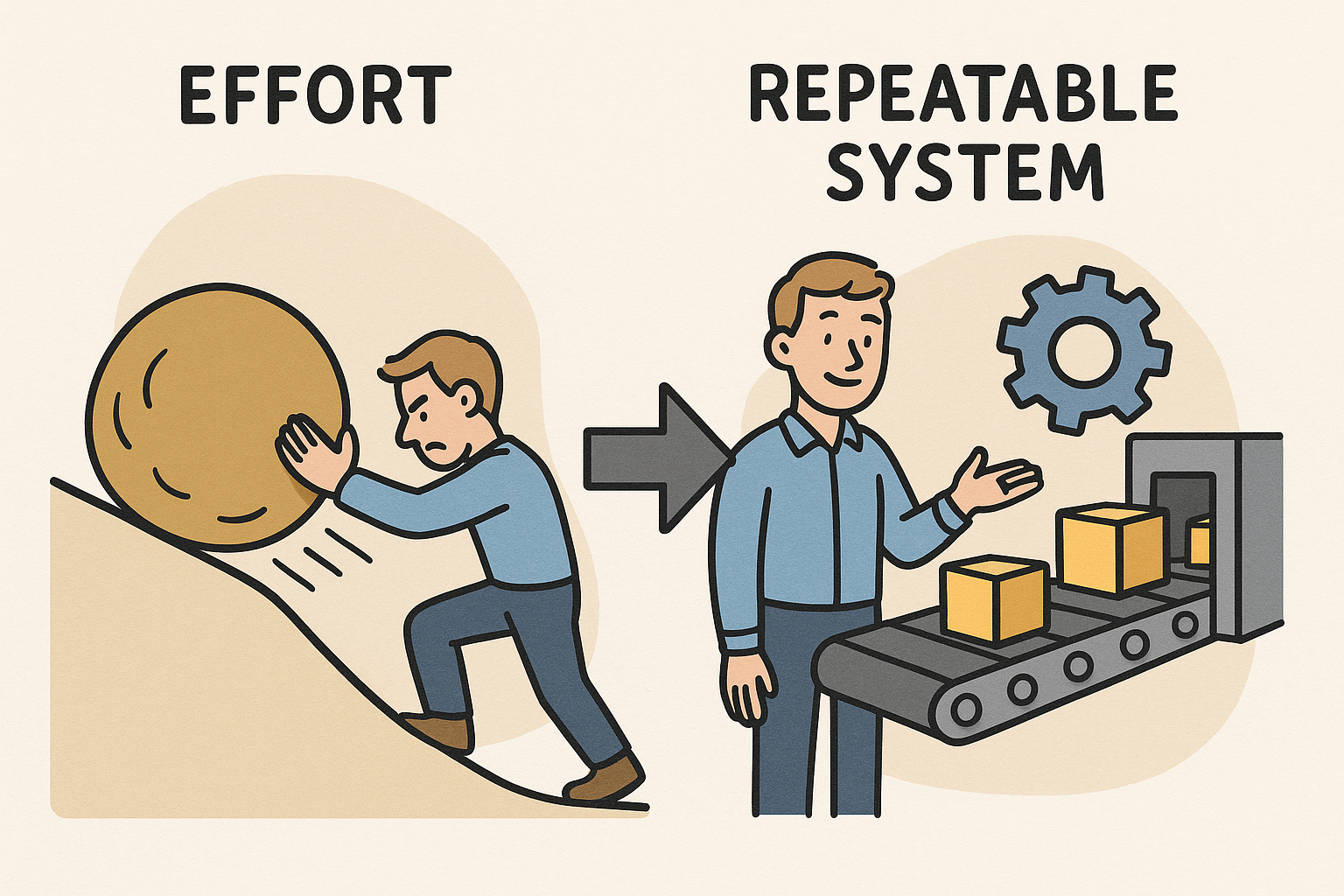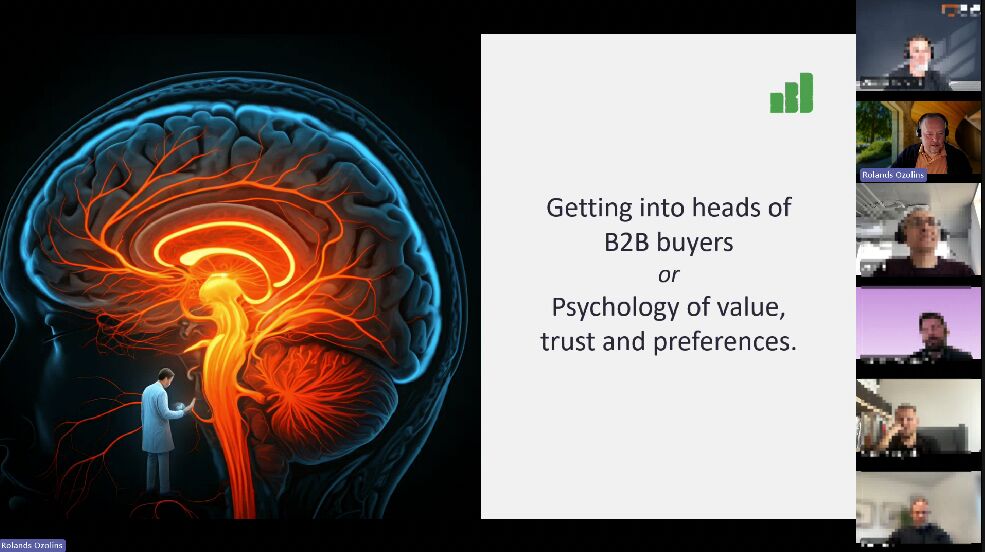I wrote this GTM Strategy planning guide specifically for tech company leaders and marketing managers in companies that:
– already have at least a few paying customers;
– are looking for ways to scale their offering in B2B markets;
– average lifetime value (LTV) of a customer if over 5000 Eur;
– relies on a sales team to close the deals.
While this guide undoubtedly will be useful for companies outside these strictly defined criterial, keep in mind that this approach has been specifically developed over time to meet planning needs of specifically these types of tech companies.
What is Go-To-Market Strategy?
In essence, a Go-To-Market (GTM) strategy is “a plan that details how an organization can engage with customers to convince them to buy their product or service and to gain a competitive advantage[1].”
This plan is developed to meet companies’ business goals considering realities and trends in the marketplace and the company’s resources and capabilities.
[1] https://www.gartner.com/en/sales/glossary/go-to-market-gtm-strategy
Why spend time and resources planning GTM Strategy?
Documented GTM strategy is an important tool for business leaders to be able to delegate marketing and sales work to others.
A company may consider that they already have clarity about the GTM strategy. However, my experience tells me that unless a company has made a deliberate effort to develop, discuss, document and regularly review its GTM strategy, different team members have different understandings of what their strategy is.
In such conditions, you cannot expect cohesive and coordinated teamwork. Therefore, despite everyone doing their best, there cannot be a good result.
Documented GTM strategy is an important tool for business leaders to be able to delegate marketing and sales work to others.
Rolands Ozolins Tweet
One main reason for having a GTM Strategy is to reach team cohesion, clarity, and shared purpose within a team. Such clarity increases synergies within the team and frees company leaders from needing to manage low-level details of everyday work.
Another important reason is the better business results you can expect with a sound GTM strategy. A good strategy produces better business results at decreased costs.
The video below is a good example of practical calculations demonstrating strategy impact on business results.
Finally, a formally documented GTM strategy allows for easy review, measurement of results against plans and quick iteration if things do not go according to plan. My experience shows that reviewing the GTM strategy every 3 to 6 months makes sense as competition evolves.
How to begin planning GTM strategy?
Before planning the GTM strategy, it is best to gather information about objective reality in the marketplace. We have found that conducting competition analysis and buyers’ interviews are the indispensable first step before getting to strategy discussions.
Competition analysis
If you were going into battle, you would certainly like to know what you are dealing with and what it would take to win. Similarly, in business, analysing competition before committing to demand generation in the market is very useful. However, it is possible that after competition analysis, you may want to review your market choices. I have had several cases when after competition analysis, my best advice has been not to enter the market. Usually, this is related to very strong competition from venture-backed competitors in overheated markets, such as the US, before 2022.
Typically, we review competitors’ websites, and analyse traffic and source of traffic. We also look at the SEO status of the competition and the keywords they are ranking for. In addition, social network analysis provides information on what content works (and what does not) on which channel. On top of that, we analyse competitors’ use of marketing content and review website codes to identify marketing and sales technologies they are using.
Usually, it is also possible to get samples of your competitors’ advertising and get advertising budget estimates.
In practice, competition analysis means a mostly manual gathering of around 50 data points and summarizing findings and recommendations in a slidedeck.
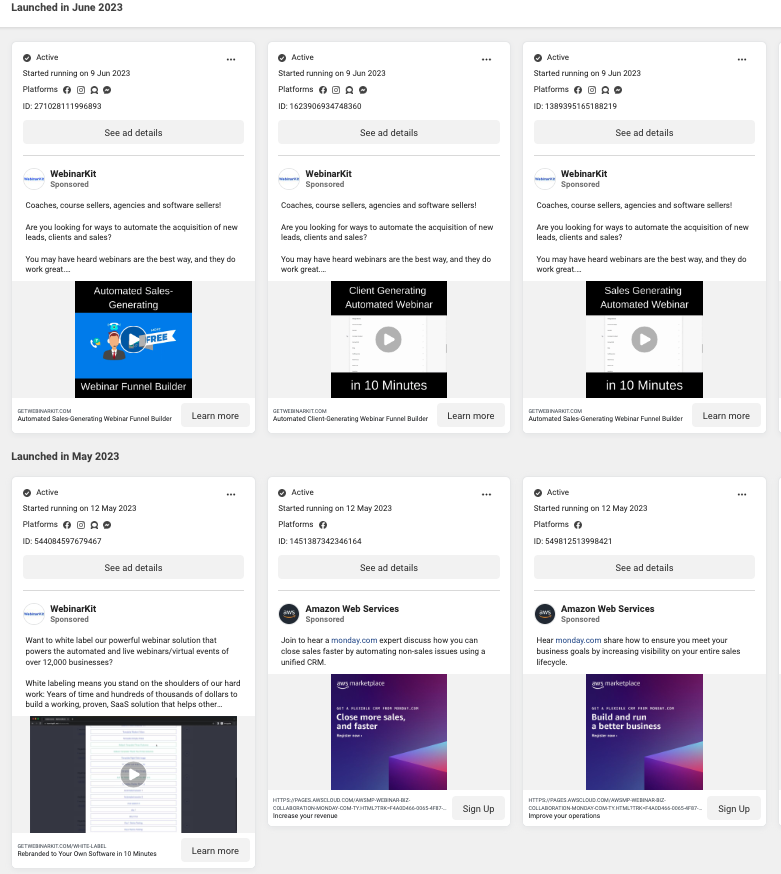
Buyers' interviews
Byers interviews are perhaps the most revealing part of market research, which reveals a lot of information that otherwise would not be available. It also prevents biases and the risk of echo chamber effect when planning strategy.
Our experience shows that existing buyers are relatively open to discussing their preferences and purchasing paths. In some cases, we have revealed very significant insights. For example, we have had instances when buyers consider that our clients are providing products in different categories than our clients think.
In addition, it is pretty common for buyers to use different language when describing the products than the language our clients use.
Some questions asked during buyers’ interviews include:
- What happened before you started to look for this offering?
- How did you learn about the offering?
- What alternatives were you considering?
- Why did you choose this offering?
- Who else was involved in the buying process?
- What is the product category?
- How would people like you learn about products like this?
GTM Strategy Planning Process
It is best if the planning process involves the company’s founder/CEO or product owner, marketing, and sales teams, as each of these parties can contribute insights into strategy development.
Before planning commences, it is recommended that the team get acquainted with modern marketing principles. This means understanding today’s buyers’ behaviours, the role of marketing content and the benefits of the latest marketing and sales technologies. Also, understanding the terminology and generally being on the same page with the rest of the team.
I estimate 2-3 hours of the briefing is sufficient for this.
The planning phase should begin with a review of competition analysis followed by a review of the results of buyers’ interviews. This creates a shared understanding of the market reality and sets the stage for the next steps.
Once the planning group is on the same page with modern marketing and reality in the marketplace, the planning process can begin.
Our experience with planning over 200 demand-generation campaigns suggests that GTM strategy planning usually takes 3 to 4 in-person or online meetings in 3 weeks.
This, however, is only possible if planning follows a proven planning framework and is conducted by an experienced process moderator. In addition, it is preferable if the process is undertaken by a person not too involved in the company’s everyday business, such as a non-executive board member or an external consultant.
10-step Go-To-Market Strategy Planning Framework
We at IBD consulting are using our own developed 10-step planning framework that has been tried and tested with hundreds of customers in tech industry. This framework allows us to focus attention on what is truly important for tech companies selling in B2B space and complete planning in 3-4 weeks.
I estimate this framework covers 95% of all situations. There are cases when some elements of the framework are redundant or cases when additional analytical frameworks, such as barriers to purchase, need to be used.
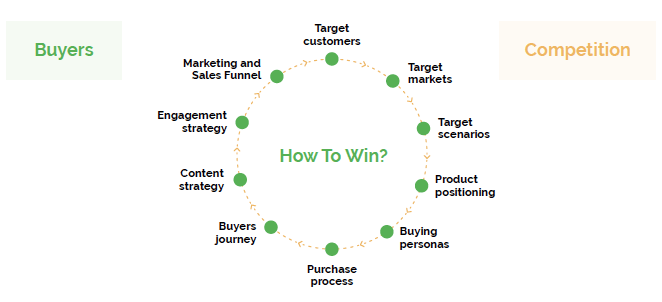
Step 1. Ideal Customer Profile (ICP)
The first step is to define the ideal customer (company) profile. Typically, we look at the industry, company size and other criteria, such as technologies used, revenue, profitability, growth rate and other indicators.
In some cases, use of European NACE2 classification allows to identify of target customers precisely, as well as access to detailed statistics about such companies.
This allows us to focus next planning steps with clear consideration for the specific customers we are going after.
Step 2. Defining Target Markets
In many cases, companies going internationally are open to considering several markets.
In this step, we analyse and compare multiple options to select the best markets to reach the company’s business goals.
In this step, we often consider the number of ICPs in the respective market (step 1), interest in the category of the offering, expected marketing costs, need for localization and other relevant criteria.
Based on business objectives and number of ICPs in the market we may recommend focussing on one or more markets.
Step 3. Target Scenarios
More often than not, technology product purchases can be driven by different needs and different buyers within a company.
A simple example is selling to new customers instead of migrating customers from an existing solution to a new one.
In this step, we compare and choose the scenario we believe has the most potential to open the doors to conversation.
As an example, in one case, buyers’ interviews revealed that buyers chose produce because of their advanced process planning features above all else. It was clear that planning was the right scenario to promote, as it offered the strongest competitive advantage and provided most value to customers.
Step 4. Product positioning
Positioning is perhaps the most important part of GTM strategy to get right.
Positioning is the way how you want your buyers to perceive your product in a way that is simple and easy to remember.
Simpler is better since you want your product to be understood with as little mental effort as possible.
In this step, we develop product positioning and positioning against key competitors. The competition analysis and buyers’ interviews provide very useful information for this step.
Positioning statements serve extremely well later when developing marketing content, such as landing pages, sales scripts, ebooks, etc.
Step 5. Developing buyers' personas
Buyers’ Persona development is a technique which summarizes the common traits of your buyers.
Typically you want to document the following:
- Title and demography
- Jobs your buyers want to accomplish with your offering
- The risks buyers want to avoid
- The information they need to know to be able to proceed with the purchase
- Objections that buyers are likely to have
- Objectives your buyers want to achieve
- Channels and media your buyers use
Buyers’ Persona profiles save time and effort when briefing content creators about the content you need to be developed. In essence, it describes target audience very well.
This is another technique which makes delegation much easier and content development simpler.
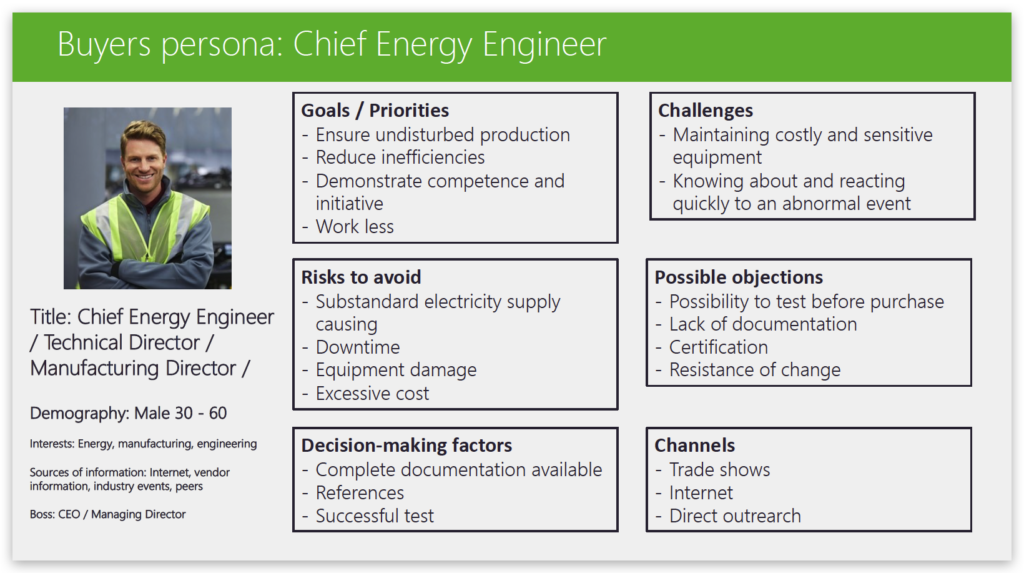
Step 6. Charting the buying process
In B2B setting, buying decisions are made in groups of several people from multiple functions.
Understanding and charting the buying process helps identify which persons at which stage in the buyers’ journey need to be engaged and educated with what kind of content.
It is quite possible that in this step, you will discover that there are additional personas involved in purchasing decisions that usually do not have direct contact with sellers, such as finance, legal or security professionals upon whose acceptance purchase decision depends.
Making a simple flowchart of the buying process is often sufficient to document the typical purchase process and identify stages in this process when you need to have content available to influence decisions.
For example, one project charting the buying process revealed that it is necessary to create specific content explaining specific data handling procedures for lawyers and data protection officers. While these persons were not usually involved in sales meetings, it was critical material necessary for their approval of the purchase.
It is important not to disregard technical buyers that, while not engaged in the purchase process, may be important behind-the-scenes decision-makers upon whose opinion purchase decision depends.
Learn more about engaging technical buyers in one of our #FriTalks webcast episodes.
Step 7. Planning the Customer Journey
Customer journey is a marketing technique that implies that before the purchase decision is made, buyers proceed through different mental stages. In these stages, they have different questions they need answers to, and therefore sellers can plan respective marketing activities and content to support buyers in their decision-making.
My experience tells me that this and a few next steps should be prepared between the planning meetings by internal marketing or consultants and then reviewed at the planning meeting.
In this step, it is necessary to consider what kind of questions which buyer’s persona would have at different stages of the buyer’s journey and what would be the best way to answer these questions.
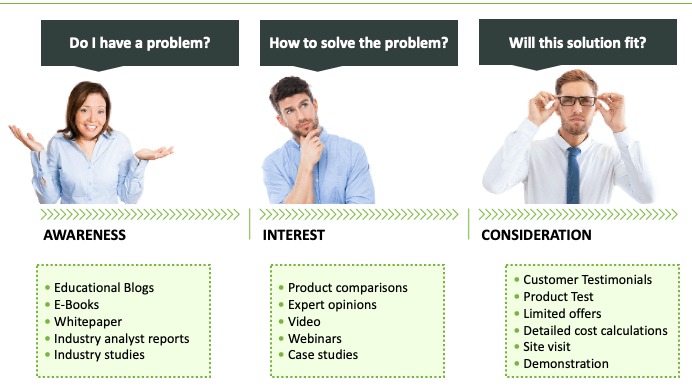
Step 8. Content strategy
Content strategy is closely related to step 6. (Customer Journey) and again – it is best done outside of meetings and results reviewed at the meeting.
The goal of this step is to plan what kind of content, such as videos, blogs, ebooks, webinars, demos etc. would be appropriate at different stages of the customer journey.
Step 9. Engagement strategy
In this step, sales funnels are planned, and the most optimal marketing channels are decided based on decisions in step 6 (Customer Journey) and step 7 (engagement strategy).
Typically, tech companies use paid channels such as Google Ads, LinkedIn or Facebook.
Less used, but in some conditions very effective, can be direct cold outreach over e-mail or phone. This works in cases when 1) it is possible to define and identify specific decision makers and 2) your solution hits an acute business pain.
Companies also must consider offline channels such as trade shows and industry events. Sometimes, PR or influencer marketing can be the most appropriate channel.
Customer interviews and competition analysis provide insights to make select the most appropriate channels.
The practical result of this and the previous two steps is a flowchart detailing channel and content use over the customer journey.
Step 10. Planning marketing and sales pipeline
The final step in GTM strategy planning is perhaps the most revealing in terms of answering the question of what exactly it will take to reach the business objectives.
In this step, we are combining all previous experience, information, assumptions, and decisions to plan how the combined marketing and sales pipeline will look like and how much we think it will cost to acquire a new customer.
While we certainly know that any projections are approximate, these calculations give a fair estimate of how the pipeline is going to look like.
This projection is immensely useful in planning business growth. Once you add on top of this calculation time perspective (basically the average time necessary to close the deal) and resources required in sale processes, such as the time of SDR (sales development representative) or presales engineer, it is possible to calculate detailed costs of sales and marketing in each stage of the pipeline, plan necessary personnel resources and plan respective cash flow from the newly generated business.
It must be noted, however, that while pipeline projection provides directional guidance and is useful to set KPIs, it is not a precise forecast.

GTM planning: outcome and deliverables
The outcome of GTM strategy planning is clarity and a shared understanding of demand generation activities that are required to meet the company’s business goals. This helps to plan marketing and sales activities supporting each other, reduce business risks and sometimes – prevent company from wasting money in efforts to reach business goals which are not attainable.
Although such situations are generally rare, we have had customers that walked away from the strategy planning process with clear and data-based conclusions that their business objectives are not attainable from a financial perspective.
The deliverables of the strategy planning process usually are slide decks with competition analysis, buyers’ interview summaries and outcomes of the 10-step planning process.
These documents must not be shelved and forgotten.
Instead, they must be used to develop messaging frameworks, internal KPIs, briefs for content creators and paid media professionals and so on.
Companies should regularly review their GTM strategy, and I recommend doing it at least twice per year.

